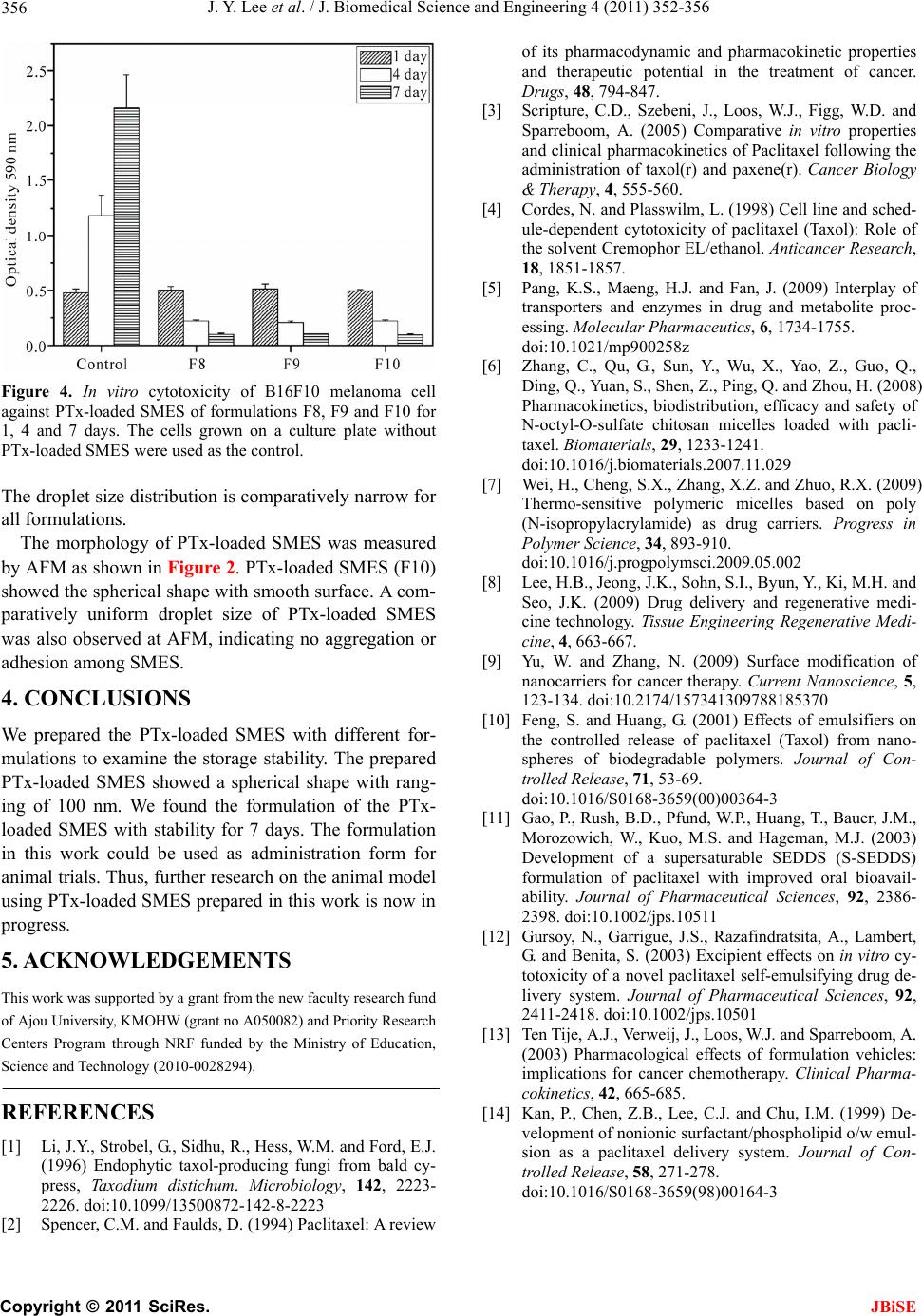
J. Y. Lee et al . / J. Biomedical Science and Engineering 4 (2011) 352-356
356
Figure 4. In vitro cytotoxicity of B16F10 melanoma cell
against PTx-loaded SMES of formulations F8, F9 and F10 for
1, 4 and 7 days. The cells grown on a culture plate without
PTx-loaded SMES were used as the control.
The droplet size distribution is comparatively narrow for
all formulations.
The morphology of PTx-loaded SMES was measured
by AFM as shown in Figure 2. PTx-loaded SMES (F10)
showed the spherical shape with smooth surface. A com-
paratively uniform droplet size of PTx-loaded SMES
was also observed at AFM, indicating no aggregation or
adhesion among SMES.
4. CONCLUSIONS
We prepared the PTx-loaded SMES with different for-
mulations to examine the storage stability. The prepared
PTx-loaded SMES showed a spherical shape with rang-
ing of 100 nm. We found the formulation of the PTx-
loaded SMES with stability for 7 days. The formulation
in this work could be used as administration form for
animal trials. Thus, further research on the animal model
using PTx-loaded SMES prepared in this work is now in
progress.
5. ACKNOWLEDGEMENTS
This work was supported by a grant from the new faculty research fund
of Ajou University, KMOHW (grant no A050082) and Priority Research
Centers Program through NRF funded by the Ministry of Education,
Science and Technology (2010-0028294).
REFERENCES
[1] Li, J.Y., Strobel, G., Sidhu, R., Hess, W.M. and Ford, E.J.
(1996) Endophytic taxol-producing fungi from bald cy-
press, Taxodium distichum. Microbiology, 142, 2223-
2226. doi:10.1099/13500872-142-8-2223
[2] Spencer, C.M. and Faulds, D. (1994) Paclitaxel: A review
of its pharmacodynamic and pharmacokinetic properties
and therapeutic potential in the treatment of cancer.
Drugs, 48, 794-847.
[3] Scripture, C.D., Szebeni, J., Loos, W.J., Figg, W.D. and
Sparreboom, A. (2005) Comparative in vitro properties
and clinical pharmacokinetics of Paclitaxel following the
administration of taxol(r) and paxene(r). Cancer Biology
& Ther apy, 4, 555-560.
[4] Cordes, N. and Plasswilm, L. (1998) Cell line and sched-
ule-dependent cytotoxicity of paclitaxel (Taxol): Role of
the solvent Cremophor EL/ethanol. Anticancer Research,
18, 1851-1857.
[5] Pang, K.S., Maeng, H.J. and Fan, J. (2009) Interplay of
transporters and enzymes in drug and metabolite proc-
essing. Molecular Pharmaceutics, 6, 1734-1755.
doi:10.1021/mp900258z
[6] Zhang, C., Qu, G., Sun, Y., Wu, X., Yao, Z., Guo, Q.,
Ding, Q., Yuan, S., Shen, Z., Ping, Q. and Zhou, H. (2008)
Pharmacokinetics, biodistribution, efficacy and safety of
N-octyl-O-sulfate chitosan micelles loaded with pacli-
taxel. Biomaterials, 29, 1233-1241.
doi:10.1016/j.biomaterials.2007.11.029
[7] Wei, H., Cheng, S.X., Zhang, X.Z. and Zhuo, R.X. (2009)
Thermo-sensitive polymeric micelles based on poly
(N-isopropylacrylamide) as drug carriers. Progress in
Polymer Science, 34, 893-910.
doi:10.1016/j.progpolymsci.2009.05.002
[8] Lee, H.B., Jeong, J.K., Sohn, S.I., Byun, Y., Ki, M.H. and
Seo, J.K. (2009) Drug delivery and regenerative medi-
cine technology. Tissue Engineering Regenerative Medi-
cine, 4, 663-667.
[9] Yu, W. and Zhang, N. (2009) Surface modification of
nanocarriers for cancer therapy. Current Nanoscience, 5,
123-134. doi:10.2174/157341309788185370
[10] Feng, S. and Huang, G. (2001) Effects of emulsifiers on
the controlled release of paclitaxel (Taxol) from nano-
spheres of biodegradable polymers. Journal of Con-
trolled Release, 71, 53-69.
doi:10.1016/S0168-3659(00)00364-3
[11] Gao, P
., Rush, B.D., Pfund, W.P., Huang, T., Bauer, J.M.,
Morozowich, W., Kuo, M.S. and Hageman, M.J. (2003)
Development of a supersaturable SEDDS (S-SEDDS)
formulation of paclitaxel with improved oral bioavail-
ability. Journal of Pharmaceutical Sciences, 92, 2386-
2398. doi:10.1002/jps.10511
[12] Gursoy, N., Garrigue, J.S., Razafindratsita, A., Lambert,
G. and Benita, S. (2003) Excipient effects on in vitro cy-
totoxicity of a novel paclitaxel self-emulsifying drug de-
livery system. Journal of Pharmaceutical Sciences, 92,
2411-2418. doi:10.1002/jps.10501
[13] Ten Tije, A.J., Verweij, J., Loos, W.J. and Sparreboom, A.
(2003) Pharmacological effects of formulation vehicles:
implications for cancer chemotherapy. Clinical Pharma-
cokinetics, 42, 665-685.
[14] Kan, P
., Chen, Z.B., Lee, C.J. and Chu, I.M. (1999) De-
velopment of nonionic surfactant/phospholipid o/w emul-
sion as a paclitaxel delivery system. Journal of Con-
trolled Release, 58, 271-278.
doi:10.1016/S0168-3659(98)00164-3
C
opyright © 2011 SciRes. JBiSE